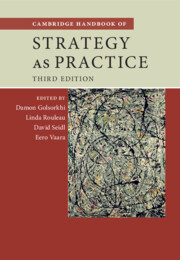Book contents
- Cambridge Handbook of Strategy as Practice
- Cambridge Handbook of Strategy as Practice
- Copyright page
- Contents
- Figures
- Tables
- Boxes
- Contributors
- Preface to the Third Edition
- Introduction: What Is Strategy as Practice?
- Part I Ontological and Epistemological Questions
- Part II Theoretical Resources: Social Theory
- Part III Theoretical Resources: Organization and Management Theories
- Part IV Methodological Resources
- Part V Substantive Topic Areas
- Index
- References
Introduction: What Is Strategy as Practice?
Published online by Cambridge University Press: 11 March 2025
- Cambridge Handbook of Strategy as Practice
- Cambridge Handbook of Strategy as Practice
- Copyright page
- Contents
- Figures
- Tables
- Boxes
- Contributors
- Preface to the Third Edition
- Introduction: What Is Strategy as Practice?
- Part I Ontological and Epistemological Questions
- Part II Theoretical Resources: Social Theory
- Part III Theoretical Resources: Organization and Management Theories
- Part IV Methodological Resources
- Part V Substantive Topic Areas
- Index
- References
Summary
Strategy as Practice (SAP) has emerged as a distinctive approach for studying strategic management, strategic decision-making, strategizing, strategy-making and strategy work (Jarzabkowski, Balogun and Seidl 2007; Johnson, Melin and Whittington 2003; Whittington 1996). In recent years, SAP research has become more popular than ever (Jarzabkowski, Seidl and Balogun 2022; Kohtamäki et al. 2022). SAP provides not only an organizational perspective into strategic decision-making but also a strategic angle for examining the process of organizing, and thereby it serves as a research programme and social movement for connecting contemporary strategic management research with organizational studies. This third edition of the Handbook offers an updated and forward-looking reflection about what we have learned and how to make the most out of this powerful perspective in future research.
- Type
- Chapter
- Information
- Cambridge Handbook of Strategy as Practice , pp. 1 - 22Publisher: Cambridge University PressPrint publication year: 2025

